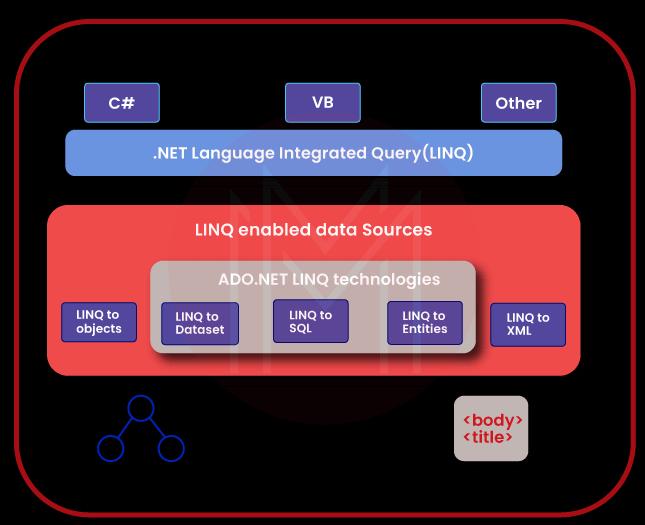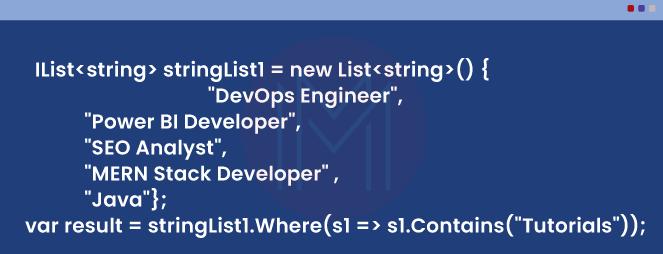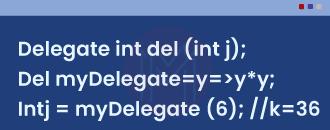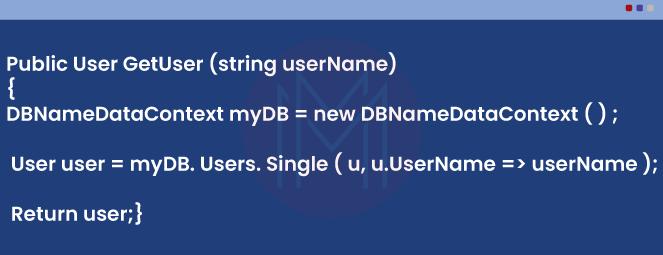LINQ is a module of the .NET framework that connects the abilities of the initial data querying to the .NET languages. It was initially launched in 2007 as an essential part of the .NET framework. It is completely integrated and provides straightforward data access from the in-memory XML documents, databases, objects, etc. It integrates Visual Basic and C# queries using a group of extensions and provides a single user interface for various data sources.
LINQ is a more helpful querying language than SQL. In Comparison with SQL, LINQ is higher-level, tidier, and more straightforward. This blog will introduce you to the most frequently asked LINQ Interview Questions and Answers. We have around 60 interview questions on LINQ that will assist you with different expertise to get the maximum benefit from our blog.
We have categorized LINQ Interview Questions - 2023 (Updated) into 3 levels they are:
Top 10 Frequently Asked LINQ Interview Questions
- What are the primary components of LINQ?
- Explain LINQ Architecture?
- Explain LinqDataSource Control?
- Describe LINQ Standard Query Operators?
- Differentiate N-Layer and N-Tier architecture?
- Describe LINQ Compiled Queries?
- What are SelectMany() and Select() in LINQ?
- Explain Query Syntax?
- How will you count the elements of a collection or a list?
- How can we retrieve the single row with LINQ?
| If you want to become a certified .Net professional, then visit Mindmajix - A Global online training platform: “.NET Online Training” Course. This course will help you to achieve excellence in this domain. |
LINQ Interview Questions and Answers For Freshers
1. Define LINQ? Why is it important?
The complete form of “LINQ” is Language Integrated Query. It is the .NET framework component that links initial data querying abilities to the .NET languages. LINQ provides simple data access from in-memory databases, objects, XML documents, etc.
2. What are the kinds of LINQ?
Following are the different kinds of LINQ:
- LINQ to XML
- LINQ to Objects
- LINQ to SQL
- LINQ to Entities
- LINQ to Dataset.
3. What are the benefits of LINQ?
Following are the benefits of LINQ:
- The main objective of utilising LINQ is fetching complicated queries in the dataset.
- We can use it for fetching the unique values from the dataset.
- LINQ is useful for combining values from two separate data sets.
- It offers more functionality than ADO.NET
- It gives the best method compared with the SQL Query of Querying dataset.
4. What are the different methods to write the LINQ query syntax?
Following are the two different methods to write the LINQ query to the data sources:
- Expression Syntax or Query Syntax
- Method Extension Syntax or the Method Syntax.
5. Define the “Let” clause and “Where” clause?
- “Let” Clause: enables us to define the variable and assign it to the value calculated from data values.
- “Where” Clause: It enables us to add some conditional filters to the query.
6. What are the primary components of LINQ?
Following are the three primary components of LINQ:
- Language Extensions
- LINQ Providers
- Standard Query Operators.
7. Explain how LINQ is more important than Stored Procedures?
- Deployment: For the Stored Procedures, we must give further scripting, yet with the LINQ, everything will be compiled into one DLL, thus making deployment easy.
- Debugging: It is not easy to debug the stored procedure, yet as LINQ is part of .NET, we can use visual studios debugger for debugging the queries.
- Type Safety: LINQ is type-safe; therefore, query errors are type-checked at compilation time.
8. Describe LINQ to SQL?
LINQ to SQL is part of ADO.NET programming. It handles the relational data as an object. LINQ to SQL transforms the language integrated query in an object to the SQL and dispatch them to the database for implementation. When database responses, the result of LINQ to SQL converts them back to the objects. LINQ to SQL endorses user-specified stored procedures and functions in the database.
| Related Article: SQL Server Tutorial |
9. Explain API in LINQ?
We can write LINQ queries for the classes that execute IQueryable or IEnumerable interface. “System.Linq” namespace offers various classes for the interface needed for the LINQ queries.
10. Explain LINQ Architecture?
LINQ contains three-layered architecture. In the uppermost layer, we will have language extensions. The bottom layer contains data sources. Generally, data sources are object implementation of the IQueryable or IEnumerable generic interfaces. Other than the fundamental LINQ query and the data sources, another element is called the LINQ provider. The applicability of LINQ providers is converting LINQ Query into the format such that existing data sources can understand it.

11. What are the differences between LINQ and Stored Procedures?
The following are the critical differences between LINQ and Stored Procedure:
- Stored Procedure is more rapid than the LINQ query as they follow the correct execution plan.
- It is simpler to avoid the runtime errors in the SQL query than comparing with the stored procedure.
- LINQ utilises a .NET debugger to enable debugging, which is not in stored procedures.
- LINQ supports multiple databases contrary to stored procedures.
- Implementation of LINQ based solution is more agreeable than the deployment of the stored procedure.
12. Explain LinqDataSource Control?
If we have to utilise the LINQ in the ASP.NET web page, LinqDataSource is the essential part of the Dataset. We use it to set properties in the markup text, control, modify, and retrieve the data. We can also use it to declaratively bind the ASP.NET controls on the page to the data source. It is the same as the ObjectDataSource, and SQL Data Source controls.
13. What is LINQ Lambda Expression?
Lambda Expression is the function with no name. Lambda Expression makes the syntax more extensive by making it more precise and short. It is equally essential as LINQ Query even though it is not readable like LINQ Query. The scope of the Lambda Expression is restricted. We cannot reuse it.
14. Explain Expression Tree?
Lambda Expressions are comprehensively used in the ExpressionTree construction. The Expression Tree represents the code in the tree format, where every node is referred to as the impression. We can transform the Expression Tree into an error-free code and execute it.
In the .NET framework, we use the expression class for creating the Expression Tree using the API. The API of Expression Trees also supports assignments and control flow expressions like loops, try-catch, and conditional blocks. We can create harder Expression Trees than those created from the Lambda Expressions through the API.
15. What is DataContext class? Explain its relation with LINQ?
The DataContext class serves as the passing item for LINQ to the SQL framework. The DataContext class is the base for all the accesses mapped on the database connection. The DataContext is thin and inexpensive to create. After inserting the LINQ into the SQL, the blank DataContext classes that we can configure are depicted by the blank design surface.
The DataContext class stores information regarding the ways of connecting to the database. DataContext also changes the data in a database. We configure the DatContext classes with linked data that is benefited by the first item.
16. Describe LINQ Standard Query Operators?
The Standard Query Operators are defined as the techniques that make the LINQ pattern. We apply these techniques to the sequences where the sequence is the object that deploys the IEnumerable<T> interface or IQueryable<T> interface. Standard Query Operators offer query capabilities for the projection, aggregation, filtering, sorting, etc.
The Standard Query Operator has two groups. One group works on the IEnumerable<T> type objects, and other operators work on IQueryable<T> type objects.
17. Explain PLINQ?
PLINQ refers to parallel LINQ. It is the parallel execution of the LINQ to the objects. It endorses parallel(analogous) programming and is closely associated with a parallel task library. PLINQ assists with some queries to spontaneously take benefit of the multiple processors. PLINQ can increase the rapidity of the LINQ to the objects through all the existing essences on the central computer more effectively.
18. Differentiate N-Layer and N-Tier architecture?
N-Layer and N-Tier are two separate concepts. Generally, we use these terms while designing the application architecture. N-Tier refers to the system and essential components of our application. On the contrary, N-Layer refers to the internal architecture of our element. Following are the main advantages of the layered architecture:
- Isolation
- Abstraction
- Manageability
- Reusability
- Performance
- Testability.
Following are the benefits of the tier architecture styles:
- Scalability
- Maintainability
- Availability
- Flexibility.
19. What difference is between FirstOrDefault() and First() selector methods in the LINQ?
The first() method always anticipates a minimum of one element in the result set. If there is not an element in the result. First() returns the exception. Whereas FirstOrDefault() is compatible with the result set containing 0 elements. It will not throw any exception.
Scenario-Based LINQ Interview Questions
20. Describe LINQ Compiled Queries?
In some scenarios, we may have to execute a specific query repeatedly. LINQ enables us to create the query and compile it. Following are some of the benefits of Compiled Queries:
- Compiled Queries do not require compiling every time; thus, query execution is rapid.
- Compiled Queries are compiled once, and we can use them any number of times.
- Compiled Queries must be recompiled even though the query parameter is being modified.
Example

21. Explain Anonymous Types?
The Anonymous types are defined as the run-time compiler created by the compiler. We don’t need to define a name for creating an Anonymous compiler, but we can define the properties' names and allocate values to them dynamically.
var v = new { PropertyFirst1 = ‘first value1’, PropertySecond1 = ‘second value1’};
Console.WriteLine(k.PropertyFirst1);Anonymous class is useful in LINQ queries. It stores the intermediate results while doing the queries:
- Anonymous types will not implement interfaces.
- Anonymous cannot define the methods.
- We cannot specify the static numbers.
- We should initialise all the specified properties.
- We can only specify the public fields.
22. Describe why the SELECT clause comes after FROM clause in the LINQ?
LINQ needs all the queries to be defined first. The “FROM” clause of the LINQ query specifies the range or condition for selecting the records. Thus, the “FROM” clause should act before “SELECT” in the LINQ query.
23. Explain LINQ providers in LINQ?
LINQ Providers are the group of classes that take the LINQ Query, which creates a method that implements the equivalent query against a specific data source.
24. What are SelectMany() and Select() in LINQ?
In the LINQ SelectMany() and Select() are the projection operators. We use the Select() operator for selecting a value from the collection, while the utilisation of the SelectMany() operator is for selecting the values from the group of a collection, i.e. the nested collection.
25. Explain Entity Classes?
In LINQ, Entity Classes are the basic building blocks of the system. They act as the object wrapper for the database table. It contains the stereotype of the entity.
26. What are the Quantifier Operators?
In LINQ, Quantifier Operators are those that return the boolean value, i.e. False or True. Following are the different kinds of Quantifier Operators:
- Any()
- All()
- Contains().
27. What are the advantages of Deferred Execution?
Deferred Execution evaluates the delayed expression till its realised value is required. It can considerably enhance the presentation when we need to affect vast data collections, particularly in the programs that encircle the series of chained queries.
28. What is an object-relational designer?
An object-relational designer offers a visual design surface for making the LINQ to SQL relations and entity class according to the objects in the database.
29. On what parameter does the GROUP BY clause group data?
The GROUP BY clause groups the basics that share the common attribute.
30. Which extension method do we require to execute the parallel query in PLINQ?
The “AsParallel” extension process is needed for running the query in the PLINQ.
31. What is the purpose of System.XML.Xlinq.dll?
System.XML.Xlinq.dll offers the functionality for working with the LINQ to SQL.
32. Differentiate Expression Lambda and Statement Lambda?
We extensively use Expression Lambdas for the construction of the Expression Trees. We cannot use the statement Lambdas for creating the Expression Trees.
33. Differentiate “ToDictionary” and “IEnumerable”?
- ToDictionary is the instance of the Directory(K, T). The “keySelector” predicate recognises the key of every item, whereas we use “elementSelector” for extracting every single item if it is provided.
- The extension method of “IEnumerable” is “AsEnumerable.” The “AsEnumerable” returns the source sequence as the object of “IEnumerable.”
34. What are SkipWhile() and Skip() extension methods?
Skip(): It takes the integer argument from the provided IEnumerable and skips the top n numbers.
SkipWhile(): It continues to skip the elements until the input condition is true. It returns all remaining elements if a condition is false.
35. Define the “Let” Clause?
In the Query Expression, we use the “Let” clause for storing the result of the sub-expression for using it in the consequent clauses. We can do this through the “Let” keyword, which produces a new range of variables and initialises with a result of the expression we supply.
36. Differentiate Take(1) and First()?
The difference between Take(1) and First() is that Take() returns the sequence of the elements that comprise only one element, whereas First() returns the element.
37. Explain the “WHERE” clause?
“WHERE” clause enables adding conditional filters to the query.
38. What are the benefits of using the LINQ Dataset?
Following are the benefits of utilising the LINQ Dataset:
- We can execute the strongly typed queries on the datasets through LINQ.
- If we want to integrate the values of the datasets or extract the unique value from the dataset, LINQ will be helpful.
- Through LINQ, we can query the dataset more efficiently with the latest features in comparison to ADO.NET.
39. Explain Anonymous Functions?
The anonymous function is defined as the function without any name. We only specify the parameters in the anonymous function and build the code in curly braces.
LINQ Interview Questions For Experienced
40. Define Action?
Action is defined as the common delegates associated with the base class library of .NET. We can save only the methods with input parameters and void return types in Action. We can specify up to 16 parameters.
41. Explain Predicate Delegate?
Predicate Delegate is offered by the basic class of the .NET library. In the Predicate, we are enabled to save only the methods with the one input parameter and the bool return type. Predicate delegates are helpful in the scenarios where the filter is required.
Check out the .Net Libraries
42. Name Command-Line that creates the code and mapping for LINQ to SQL component of the .NET framework?
“SqlMetal.exe” is the command-line tool that creates the code and maps LINQ to the SQL element.
43. What is LINQ to XML?
LINQ to XML offers integral document modification abilities of DOM and supports the LINQ queries. Through it, we can amend the query and store the modifications of the XML document. It allows us to develop the queries and recover and lead a compilation of the attributes and elements.
44. Explain “LINQ to Objects”?
When the LINQ queries any IEnumerable or IEnumerable() collection without utilising the intermediary LINQ provider or the API like LINQ to XML or the LINQ to SQL is known as the LINQ to objects.
45. Differentiate the Take and Skip clause?
We use the “Take” clause for returning only a certain number of elements. While the “Skip” clause hops a certain number of elements and returns the remaining elements.
46. What are Sequence and Query Operators in LINQ?
The sequence is defined as the collection class we have to query. The element is the single item in the collection class, and the class should implement the IEnumerable interface. Query Operators comprehend the sequence as the input, implement it and return the latest result sequence.
47. LINQ query is implemented in which statement?
In VB, the LINQ query is implemented in the “For Each” statement and in the “foreach” statement for the C#.
48. Explain Extension Methods?
The extension methods are the static functions of the static class. We can invoke these methods the same as the syntax of the instance method. We can use these methods when we don’t need to modify the class.
49. How can we find an index of elements through Where() with Lambda Expression in LINQ?
For finding an index of the element through the overloaded version of the Where() with Lambda Expression:
Where((j, jx) => j = = jx);50. What is the difference between utilising the LINQ to SQL and Entity Framework as the ORM?
- LINQ to Entities is the ORM API that allows a wide definition of the object domain models and relationships to various ADO.Net data providers. By definition, we can combine and match various database vendors, application protocols or servers for designing the aggregated mash-up of the objects built from different services, tables, sources, etc.
- LINQ to SQL supports only 1 to 1 mapping of the database views, tables, functions, and sprocs available in the Microsoft SQL Server. It is the best API for rapid data access production to comparatively well-developed SQL Server databases. LINQ2SQL was launched with .NET Framework 3.5 and C#3.0.
51. Explain Query Syntax?
Query Syntax is the same as the Structured Query language to the database. It is enclosed within VB or C# code.
Syntax:

Following are some essential topics of Query Syntax:
- It begins with the “FROM” keyword and finishes with the “GROUP BY” or “SELECT” keyword.
- It is similar to the SQL syntax.
- It utilises different operators like grouping, joining, filtering, and sorting for constructing the required result.
- It utilises implicitly typed variables for storing results of LINQ Query.
52. Describe LINQ method syntax?
LINQ method syntax or fluent syntax utilises other methods covered in Enumerable or Queryable static class.
- Method syntax is similar to invoking the extension method.
- LINQ Method Syntax is also called fluent syntax as it assists a group of extension methods to call.
- We can use an Implicitly typed variable for storing the results of the LINQ Query.
Syntax:

53. How will you count the elements of a collection or a list?
We use Count() function for counting the number of the items in the list.
Syntax
In C#

In VB.net

54. What is the fundamental syntax of the LINQ Query in the Visual Basic and C#?
In the Visual Basic, we use the “From” keyword for starting the LINQ Query’s fundamental syntax, and it finishes with GROUP By or Select Keyword. We can use other keywords like Order By, where, Order By Descending, etc., to perform additional functions like creating or filtering data in a particular order.
In the C#, the fundamental syntax begins with the “From” keyword and “ends” with GROUP BY or Select keyword. We can also use other clauses like Order By, Where, Order By Descending, etc., to carry out other tasks like creating or filtering data in a particular order.
55. How can we allocate the Lambda Expression to a delegate?
For allocating the Lambda Expression to a delegate:

56. What is the use of standard query operators in LINQ?
We use Standard Query Operators to
- Retrieve the total count of elements in a collection.
- Order the results of the collection.
- Calculate Average
- Grouping
- Filter results
- Joining the two collections according to the matching keys.
57. How can we retrieve the single row with LINQ?
For retrieving the single row with the LINQ, we require

58. How can we use LINQ with the databases?
LINQ supports SQL, XML, Objects, and Datasets. Using the LINQ to Datasets or LINQ to objects, we can utilise the LINQ with other databases. The datasets and Objects look after the database operations, and LINQ only requires to handle with those objects and not database operations.
Conclusion
These are some of the LINQ interview questions and answers that include both fundamental and advanced concepts of LINQ. The topics that you mastered from this LINQ interview questions blog will help you crack your job interviews.
 On-Job Support Service
On-Job Support Service
Online Work Support for your on-job roles.

Our work-support plans provide precise options as per your project tasks. Whether you are a newbie or an experienced professional seeking assistance in completing project tasks, we are here with the following plans to meet your custom needs:
- Pay Per Hour
- Pay Per Week
- Monthly
| Name | Dates | |
|---|---|---|
| .NET Training | Jan 17 to Feb 01 | View Details |
| .NET Training | Jan 20 to Feb 04 | View Details |
| .NET Training | Jan 24 to Feb 08 | View Details |
| .NET Training | Jan 27 to Feb 11 | View Details |

Viswanath is a passionate content writer of Mindmajix. He has expertise in Trending Domains like Data Science, Artificial Intelligence, Machine Learning, Blockchain, etc. His articles help the learners to get insights about the Domain. You can reach him on Linkedin
















